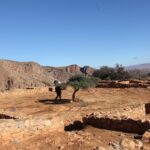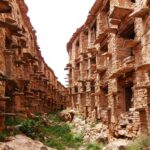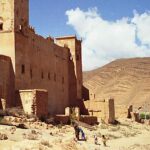Part of the imposing massif of Jbel Imzi, a botanical marvel concealed by the enigmatic Dragon Tree (Dracaena), is hidden in the western part of the Anti-Atlas mountain range. In 1996, it was discovered about 75 kilometers to the northeast of Tiznit city. This endemic tree has magically attracted botanists and explorers since its discovery for its unique appearance and characteristics.
The Dragon Tree
The Dragon Tree alone is enough to show nature’s resourcefulness, as it is palm-like in structure with alien-like foliage. Rising from several trunks, this giant specimen reaches heights of 6 to 10 meters when it contrasts with a dramatic cliff as its background.
The Legend of the Red Sap
The crimson sap that the Dragon Tree holds in its veins is a source of great mystique and romance. The local legend gets mingled with botanical marvels as the scarlet drink, referred to as the mythical dragon’s blood, starts showing up when the cut tree is wounded. This bright color hypnotizes, inviting us to let our imagination run wild and our fascination flourish. Over the course of many years, this natural wonder has been celebrated for its duality, in both a spiritual and utilitarian way. The sap drying process is only the first step that sends it beyond its botanical nature. Now it becomes a colorful paint that not only enriches textiles but also the cultural heritage of ancient societies, keeping it alive for centuries.
Ajgal: The Inaccessible
In the local Berber language, the Dragon Tree renders to “Ajgal,” which translation is “the inaccessible.” These names reflect the tree’s rugged and remote habitat, snuggling among the high cliffs of the Anti-Atlas.
A Living Relic of Antiquity
Besides being lovely and having an abundance of myths in it, the Dragon Tree has survived the course of history as it gives unique information on the ecological history of the area as well as the types of birds and insects that live there. The more the researchers explore the intricacies of this link, the more it becomes apparent how the relationship between the tree and the people endemic to the Anti-Atlas has been time-honored for ages. The Dragon Tree has made significant contributions to our concept of health and life, together with developing humanity’s dance with nature, until today.
Diverse Adventures Await
The dragon tree, so beloved by those who travel for the magic of the natural world that the Anti-Atlas Mountains offer, offers a great option for someone who loves the breathtaking scenery. In addition, visitors to the Rainforest Tree may be able to attend guided tours and hiking expeditions, which will give them a chance to wander the harsh surrounding environment around it, supported by the tour guide sharing significant information regarding the local flora and fauna along the way. The birdwatchers will be spellbound when they go into this vast habitat where there are rare species of birds, and photographers will find their inspiration just in the wild scenery and monumental rocks.
Berber Heritage Odyssey
The area further from Dragon Tree is an integral part of the community, not only for its natural beauty but also for its rich cultural heritage, to the point that traveling gives people the opportunity to connect with the indigenous Berber tribes that have made this land their home for generations. Cultural trips give the best outlook on the traditional way of life of the Berber people. These village tours, with food tastings and craft lessons, are the center of local life and artisans. Those travelers who want to come closer to the history and culture of the region have the possibility to join in the excursions with the native guides to very nearby archaeological sites and ancient rock paintings. The result of these trips is that they give travelers a unique chance to experience the incredible historical past of the region and enrich their overall travel experience.
















































